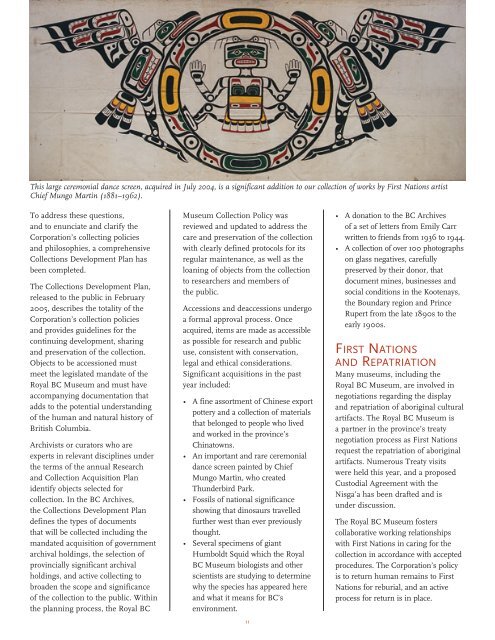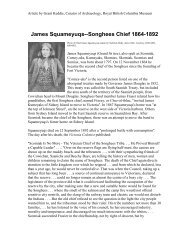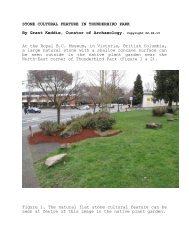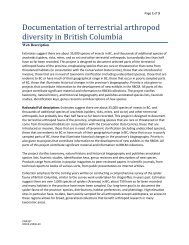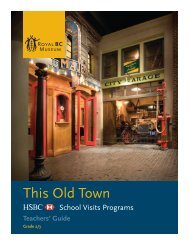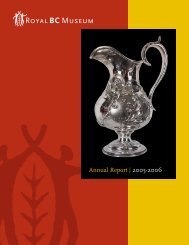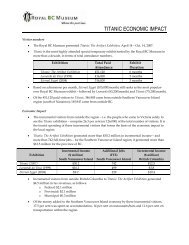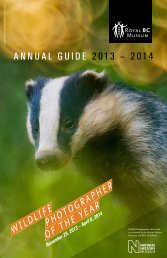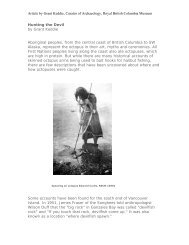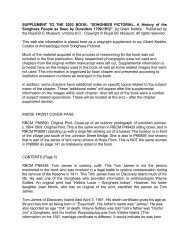View PDF - Royal BC Museum
View PDF - Royal BC Museum
View PDF - Royal BC Museum
Create successful ePaper yourself
Turn your PDF publications into a flip-book with our unique Google optimized e-Paper software.
This large ceremonial dance screen, acquired in July 2004, is a significant addition to our collection of works by First Nations artist<br />
Chief Mungo Martin (1881–1962).<br />
To address these questions,<br />
and to enunciate and clarify the<br />
Corporation’s collecting policies<br />
and philosophies, a comprehensive<br />
Collections Development Plan has<br />
been completed.<br />
The Collections Development Plan,<br />
released to the public in February<br />
2005, describes the totality of the<br />
Corporation’s collection policies<br />
and provides guidelines for the<br />
continuing development, sharing<br />
and preservation of the collection.<br />
Objects to be accessioned must<br />
meet the legislated mandate of the<br />
<strong>Royal</strong> <strong>BC</strong> <strong>Museum</strong> and must have<br />
accompanying documentation that<br />
adds to the potential understanding<br />
of the human and natural history of<br />
British Columbia.<br />
Archivists or curators who are<br />
experts in relevant disciplines under<br />
the terms of the annual Research<br />
and Collection Acquisition Plan<br />
identify objects selected for<br />
collection. In the <strong>BC</strong> Archives,<br />
the Collections Development Plan<br />
defines the types of documents<br />
that will be collected including the<br />
mandated acquisition of government<br />
archival holdings, the selection of<br />
provincially significant archival<br />
holdings, and active collecting to<br />
broaden the scope and significance<br />
of the collection to the public. Within<br />
the planning process, the <strong>Royal</strong> <strong>BC</strong><br />
<strong>Museum</strong> Collection Policy was<br />
reviewed and updated to address the<br />
care and preservation of the collection<br />
with clearly defined protocols for its<br />
regular maintenance, as well as the<br />
loaning of objects from the collection<br />
to researchers and members of<br />
the public.<br />
Accessions and deaccessions undergo<br />
a formal approval process. Once<br />
acquired, items are made as accessible<br />
as possible for research and public<br />
use, consistent with conservation,<br />
legal and ethical considerations.<br />
Significant acquisitions in the past<br />
year included:<br />
• A fine assortment of Chinese export<br />
pottery and a collection of materials<br />
that belonged to people who lived<br />
and worked in the province’s<br />
Chinatowns.<br />
• An important and rare ceremonial<br />
dance screen painted by Chief<br />
Mungo Martin, who created<br />
Thunderbird Park.<br />
• Fossils of national significance<br />
showing that dinosaurs travelled<br />
further west than ever previously<br />
thought.<br />
• Several specimens of giant<br />
Humboldt Squid which the <strong>Royal</strong><br />
<strong>BC</strong> <strong>Museum</strong> biologists and other<br />
scientists are studying to determine<br />
why the species has appeared here<br />
and what it means for <strong>BC</strong>’s<br />
environment.<br />
11<br />
• A donation to the <strong>BC</strong> Archives<br />
of a set of letters from Emily Carr<br />
written to friends from 1936 to 1944.<br />
• A collection of over 100 photographs<br />
on glass negatives, carefully<br />
preserved by their donor, that<br />
document mines, businesses and<br />
social conditions in the Kootenays,<br />
the Boundary region and Prince<br />
Rupert from the late 1890s to the<br />
early 1900s.<br />
FIRST NATIONS<br />
AND REPATRIATION<br />
Many museums, including the<br />
<strong>Royal</strong> <strong>BC</strong> <strong>Museum</strong>, are involved in<br />
negotiations regarding the display<br />
and repatriation of aboriginal cultural<br />
artifacts. The <strong>Royal</strong> <strong>BC</strong> <strong>Museum</strong> is<br />
a partner in the province’s treaty<br />
negotiation process as First Nations<br />
request the repatriation of aboriginal<br />
artifacts. Numerous Treaty visits<br />
were held this year, and a proposed<br />
Custodial Agreement with the<br />
Nisga’a has been drafted and is<br />
under discussion.<br />
The <strong>Royal</strong> <strong>BC</strong> <strong>Museum</strong> fosters<br />
collaborative working relationships<br />
with First Nations in caring for the<br />
collection in accordance with accepted<br />
procedures. The Corporation’s policy<br />
is to return human remains to First<br />
Nations for reburial, and an active<br />
process for return is in place.


